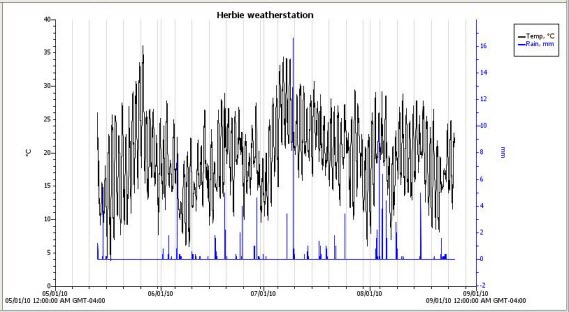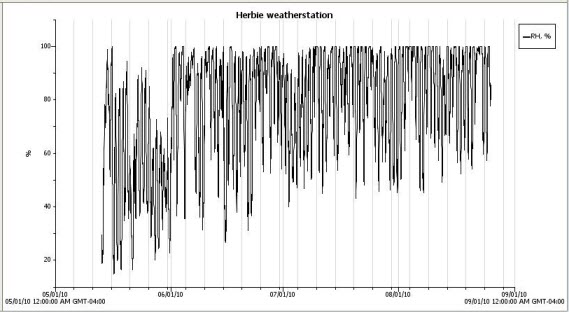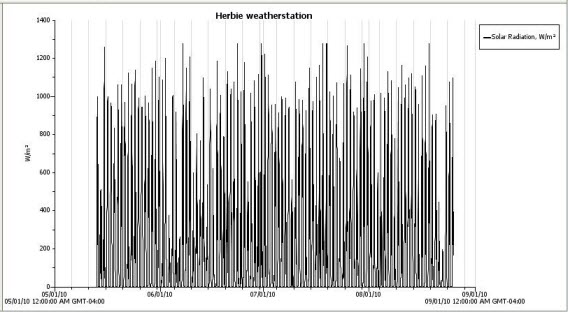1) Light Emitting Diodes
1a) Use of LEDs for shelf life extension of leafy greens
Projects funded by U Technology and NSERC CRD
More than $7 billion of fresh produce is wasted in Canadian grocery stores every year, primarily because stores prefer to showcase/sell produce that looks appealing to their customers. This not only creates a negative social and environmental connotation associated with food wastage, but it also represents a lost revenue stream for Canadian retailers and is a cost to taxpayers who pay large sums to dispose of the biomass. A recent study in our laboratory has shown that the shelf-life of vegetables can be increased by illuminating them with the correct intensity and wavelength of LED lights, instead of the fluorescent lamps that are currently found in grocery stores. Exposure to the correct LEDs can prevent wilting in leafy vegetables by regulating plant respiration thereby conserving leaf 'crunchiness'.
The LED light manufacturer, U Technology Corporation has identified postharvest storage of fruits and vegetables as a potential market segment that they can capture. However, while U Technology Corporation currently manufactures LEDs for profile lighting in the domestic and commercial sectors but their lights are not geared towards vegetable storage. Moreover, although the effects of LED wavelengths on biomass preservation have been researched, few studies have been done to look into the impact of light intensity on fruits and vegetables. As a result, this collaborative research project was initiated between U Technology Corporation and McGill University to test different LED wavelengths at different intensities to study the versatility of LEDs in postharvest storage of spinach, kale and basil. The principal applicant, Dr. Lefsrud, has an established research program in the enhancement and control of plant growth environments with 26 publications in the area. He is an expert in plant production with different lighting systems (LED and other supplemental lighting), nutrient delivery systems and heating of controlled environments. Mr. Kam Hammad is the Chief Executive Officer of U Technology Corporation with over 10 years of experience in conducting lighting audits and LED fabrication.
1b) Amber light LED narrow wavelength plant growth system
Project funded by NSERC I2I
Light-emitting diodes (LEDs) are slowly becoming the primary lighting source in controlled environments. However, high pressure sodium (HPS) are still preferred by most growers as they result in higher yield and better plant quality for most plants when compared to LEDs. The advantage of LEDs over HPS lamps and other conventional lighting sources is the ability to select specific wavelengths of light, but most manufactures provide red (620 nm to 680 nm) and blue (420 nm to 460 nm) LEDs with limited wavelengths outside of this spectrum with nothing in the amber range where HPS is highest. Optical filters are tools that can be used to control LED wavelength characteristics. The goal of this proposal is to target specific wavelengths of light that impact plant growth and filter the light between 1 and 10 nm of precision with an ultimate goal to reach 1 nm and use this light to design light recipes to enhance plant growth. Our project objective is to construct and test a LED narrow wavelength plant growth (LED-NWPG) optical filter system that can be used to select the wavelengths of amber light, mimicking and surpassing the plant growth rate of the HPS lamps through improved biomass, leaf width and photosynthetic rate.
Past Projects Funded by HydroQuebec
LED Lettuce, HydroQuebec Reports
English Full Report: led_hps_hydroquebec_final_report.pdf;
English Summary: led_lettuce_summary_of_experiment.pdf;
French Summary: del_sommaire_dexperimentation.pdf;
2) Plant Rooting Substrate
Improvement of Porous Concrete for Horticultural Applications
Projects funded by Innovertec, CEMEX and NSERC CRD
This research grant is focused on the testing and optimizing of porous concrete as an environmental control system for humidity and temperature control (HVAC control) and as a substrate for horticultural production. Porous concrete has the ability to be formed into almost any shape, making this construction material very attractive for numerous applications.A set of experiments in our laboratory have shown remarkable plant growth in comparison to prior porous concrete mixtures. We expect this research to allow for improved environmental control for greenhouse and controlled environment structures and will lead to other novel approaches using porous concrete for building environmental control and improved green wall methods to allow plant growth on almost any structure, specifically for greening cities.
We have broken down this research into two main parts:
- on the development and testing applications of porous concrete as an environmental control system and growth media and
- improving the quality and stability of the porous concrete for plant growth and testing different methods.
Our earlier research has shown improvements in the growth rates of radish. These positive results from the preliminary testing, in collaboration with our industry partners Innovertec and Cemex are providing support and direction for the expansion of this project. Innovertec is a start-up company building technology for green roof, greenwall and horticultural applications, while CEMEX is a world leading concrete and construction company. Our first step is to build on our earlier success growing plants on the porous concrete and develop this technology to provide a substrate for plant growth which can have application in agriculture, horticulture, architecture and in reclamation projects. We will develop the technology to use porous concrete for environmental control, develop greenwall technology, improve the quality and stability of the porous concrete for plant growth and perform field testing of the porous concrete under greenhouse conditions.
3) Biomass and Biofuel Research
Past Projects
4a) Harvest and Post Harvest Densification -BioFuelNet
Lefsrud, M. and L. Tabil (University of Saskatchewan)
Agricultural and forest biomasses are the primary renewable feedstocks for making bio-fuels and bio-products. However, the development of conversion and end-use technologies will be in vain if the needed feedstock do not meet quantity and quality criteria throughout the value chain. This research project has been investigating feedstock from field harvest through to densification to the final conversion and energy extraction, with a strong focus on the logistics of this pathway. One of the major components of this project has been the research of a down draft gasifier to produce bioenergy from different types of biomass feedstock. The results showed that the shape and size of the feedstock can significantly influence the flowability of the material inside the reactor creating operational issues. Our results have shown that the bigger and bulkier material result in less operational challenges, while low density material and smaller sized feedstock results in bridging of the feedstock. Through the selection of the proper feedstock, size and shape, we can avoid the limitations of the gasifier and optimize its operation. Testing of new wheat stem varieties both with solid stem and hollow stem to look into the variation of mechanical properties (tensile, shear, cutting, compression) that affect the harvesting and handling of agricultural residues is performed. Moisture content of stem is the main factor that affects these mechanical properties. Densification studies of wheat straw and other agricultural residues are undertaken to determine whether binders are needed in forming pellets. Crop straws are known to be difficult to pelletize and we have identified binders that can be used in the pelletizing process. Optimization of binders and other variables during pelletizing process are being undertaken. Work on biomass compositional analysis through FTIR-PAS was also undertaken.
4b) Biomass Furnace Flue Gas Emission Control System (GECS) for Greenhouse Carbon Dioxide Enrichment - Phase I
Funded by NSERC I2I
The aim of the Biomass Furnace Flue Gas Emission Control System (GECS) is to improve a biomass furnace to recuperate the heat and the CO2 lost through the flue gas and redirect them for use in a greenhouse. An innovative emission prototype system was designed, constructed and installed on the chimney of a wood pellet biomass furnace. The prototype GECS consists of a filter component, catalytic component, fans, and heating elements. The GECS was able to reduce CO, NOx, and SO2 at or below the levels required for human and plant health standards. This prototype GECS proved the feasibility of our system but we need to improve the unit, specifically, the particulate filtering, catalytic system, air flow, and integration and packaging before producing a commercial unit suitable for installation into a commercial greenhouse. We will then use the improved GECS to collect scientific data to support our emission, heat recovery and CO2 enrichment abilities.
Older Reports
Consult newspaper publication on the project: Biomass Heating for Improved Greenhouse Efficiency
English Final MAPAQ report: mapaq_final_report.pdf
French FInal MAPAQ report: mapaq_report_french_version.pdf
5) Plant Proteomics
Funded by NSERC
The environment exerts significant influence on the development of plants. The proposal herein, outlines a method for integrating engineering methods for the improvement of plant production, utilizing analytical tools (including HPLC and mass spectrometry) to monitor carotenoid accumulation in model plant species. The research will focus on Arabidopsis thaliana and tomato (Solanum lycopersicum L.). Particular focus will ascertain the impact that light, specifically narrow spectrum wavelengths, exerts on both plant yield, and metabolite production (chlorophylls and carotenoids). Furthermore, the protein pathways corresponding to these environmental interactions will be elucidated. The impact of wavelength will be controlled through the modification of in-house light emitting diode arrays and optical light fractionating equipment, while mitigating the influence of other external influences. Plants require light for photosynthesis, as well as to mediate many hormonal and morphological changes. The principal purpose of light is to catalyze chemical reactions within chloroplasts through the process of photosynthesis, determined by the absorbance characteristics of chlorophyll a and b, as well as the carotenoids, lutein and ß-carotene. Specific colors and higher intensity wavelengths result in improved photosynthesis and ultimately plant growth; however, specific absorbance peaks do not always correlate to maximum plant production. For example, green light is not absorbed well by these pigments, but indeed does produce healthy plants. The photosynthetically active radiation (PAR) curve represents the percentage of light absorbed and utilized by the different pigments in the plant as a function of wavelengths (between 400 and 700 nm). The curve has been developed based on the photosynthetic efficiency (action spectrum) and plant pigment light absorbance curves, whereby maximum growth occurs in the red and blue spectrums of light, whereas suboptimal growth is observed in the green region. Although light emitting diodes (LEDs) have very narrow wavelength ranges (40 nm) the development of a series that span over the complete range of PAR promotes tresearch to determine the impact of wavelength on plant growth.
6) Food Security in Northern Canada
Food security has become an increasing concern in northern Canada because fresh nutritious food is not accessible to individuals and families for a number of reasons. High transportation costs inflate the cost of food which degrades its quality, while weather and road conditions also limit accessibility during certain periods of the year. The Canadian Integrative Northern Greenhouse (CING) unit is a possible solution to food insecurity in northern Canada. This northern greenhouse is constructed within a standard shipping container for ease of transport that has the ability to function as a closed growth chamber during the winter months and as a solar greenhouse during the summer months. The transition between growth chamber and solar greenhouse is achieved by closing or opening the unit’s outer retractable insulated panels. Closing the panels converts the unit into a growth chamber limiting heat loss during spring and fall nights and the winter months. Opening the panels allows the unit to function as a solar greenhouse. Within the unit, is a complete heating and ventilation system, a custom made high production rate hydroponic growing system with integrated inter-canopy supplemental LED lighting. The CING unit includes a fully automated sensor based control system, activating all the unit’s components from the opening and closing of the exterior panels, LED lighting, irrigation to ventilation and heating. A full scale working prototype has been built with intensified testing of the unit to be continued. Yields of different produce will be compared to yields obtained for similar plants grown in a traditional gutter style greenhouse. Energy and water consumption will also be analyzed for further optimization and enhancement of the unit. The CING unit will enable northern Canadian communities to grow fresh nutritious food year-round, in an energy efficient and economically viable way.
7) Oilseed Pea
M. Lefsrud, J. Singh, T. Warkentin, Lefsrud Seed and Processor, and Agrocentre Belcan.
NSERC CRD and CRIBIQ funded
This grant is for the multiplication, field screening, development, and initial breeding of an oilseed field pea for use in the biodiesel market. Through our preliminary screening of 6 accessions, we have found an average of 12% lipid content within field peas which is significantly larger than the industry accepted values of less than 2%. This largely unknown lipid content in field pea will allow pea to compete with both canola (less than 35% oil) and soybean (less than 20% oil). Over the last few years it has become obvious that large quantities of agricultural products will be used to meet society's energy needs. This demand places increased stress on Canada's agricultural sector to supply both food and energy. The development of an oilseed pea provides a new means to produce lipids that will strongly benefit Canada while both increasing the number of crops available for the Canadian farmer, and reducing crop inputs through reduced requirement for nitrogen fertilization. Pea has never been used by the public as an oil source and has potentially less conflict between food versus fuel markets than traditional oilseed crops. The development of an oilseed pea has added environmental and economic benefits over canola and/or soybean, such as the ability to fix nitrogen, grow in Canada's cooler climate, and have both high edible protein and oil content. Field pea is already grown throughout western Canada which decreases the challenges of market penetration and acceptance by the farming community. This grant's overall goal is for pea accession seed multiplication, screening for lipid content, breeding, and implementing the oilseed pea project to develop a novel new oilseed crop for Canada. The project has already seen a lot of development in the last couple of months and the peas that are being processed are planted right in front of the McGill Horticulture Research Center and Belcan.
English Final Report: final_report_oilseed.docx
Agrocenter Belcan weather data
The following data was collected from a weather station (codename Herbie), located in the plot right in front of the Belcan Research Center in Montreal. The data was continuously collected from May onwards (up to present date) at an interval of 10 minutes.The data that is shown in the excel file contains information about light intensity, temperature, relative humidity, precipitation, wind speed, gust speed and wind direction.
- Belcan Weather Data 2010 [.csv]
- Belcan Weather Data 2013 [.csv]
The following graphs show the change in the amount of precipitation and temperature, relative humidity, solar radiation and wind speed over the time period.







